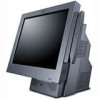IBM 4840-563 System Reference - Page 66
Cash drawer commands, Open cash drawer 1, Cash drawer status information, MSR data received
 |
View all IBM 4840-563 manuals
Add to My Manuals
Save this manual to your list of manuals |
Page 66 highlights
33: Simplified Chinese -GB-2321 34: Traditional Chinese -BIG5 Cash drawer commands This section describes the following cash drawer commands: v Open Cash Drawer 1 v Open Cash Drawer 2 v Close Cash Drawer 1 v Close Cash Drawer 2 Open cash drawer 1 To open cash drawer 1, use the following command, which sends an ASCII Bell character to the customer display serial port: 07 Open cash drawer 2 To open cash drawer 2, use the following 2-command sequence, which sends an Escape character followed by an ASCII Bell character to the customer display serial port: 1B 07 Status cash drawer 1 To obtain status information for cash drawer 1, use the following command, which sends an ASCII Ack character to the customer display serial port. See "Cash drawer status information" for a description of the cash drawer status byte. 06 Status cash drawer 2 To obtain status information for cash drawer 12, use the following 2-command sequence, which sends an Escape character followed by an ASCII Ack character to the customer display serial port. See "Cash drawer status information" for a description of the cash drawer status byte. 1B 06 Cash drawer status information To obtain status information for a cash drawer, send one of the status commands just described. The status byte returned indicates one of the following: MSR data received This section describes the data received from the MSR when a card is swiped. The MSR is an input-only device, and therefore does not use commands. The JUCC MSR attaches to a serial port as a standard RS-232 device. The 3-track MSR has a slide switch, which enables you to connect it either as a standard RS-232 serial device or through the keyboard interface. (If you choose the latter connection, the incoming data appears to come from a keyboard so no device driver is needed.) SurePOS 500 Model XX3 Technical Reference, v 1.3 81 Page 66 of















